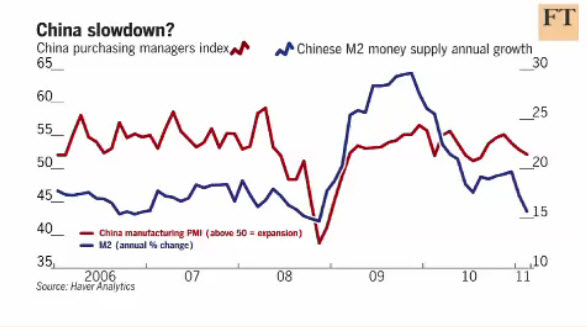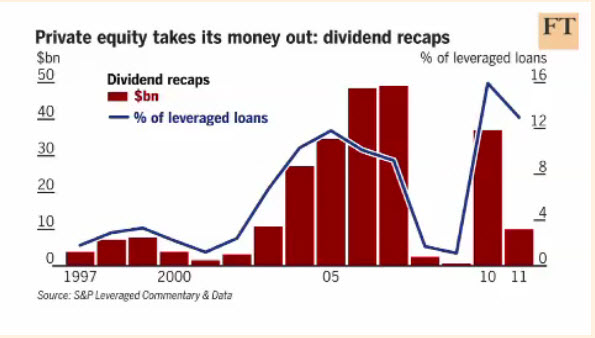Meltzer – US inflation is coming
Interview of Allan Meltzer, the outspoken historian on the Fed:
Is China next?
With ongoing revolutions in Middle East, and one authoritarian regime falling after another, Francis Fukuyama, philosopher and an expert in political economy, currently at Stanford University, discusses his view with regard to whether China will be the next.
His conclusion is that it is not likely, at least for now. This is because China's middle class, beneficiaries of the economic reform in the past 30 years, a large majority, are quite content with the status quo. But any hiccups in China's economic growth (potentially spurred by some kind of mismanagement of economy, such as a burst of housing bubble) may change the equation completely.
The piece is from the Journal, on March 12.
But do these remarkable developments tell us anything about the possibility for future instability in China?
…revolutions are made not by the poor but by upwardly mobile middle-class people who find their aspirations stymied, and there are lots of them in China. Depending on how you define it, China's middle class may outnumber the whole population of the United States. Like the middle-class people of Tunisia and Egypt, those in China have no opportunities for political participation. But unlike their Middle Eastern counterparts, they have benefited from a dramatically improving economy and a government that has focused like a laser beam on creating employment for exactly this group.
To the extent that we can gauge Chinese public opinion through surveys like Asia Barometer, a very large majority of Chinese feel that their lives have gotten better economically in recent years. A majority of Chinese also believe that democracy is the best form of government, but in a curious twist, they think that China is already democratic and profess to be satisfied with this state of affairs. This translates into a relatively low degree of support for any short-term transition to genuine liberal democracy.
Indeed, there is some reason to believe that the middle class in China may fear multiparty democracy in the short run, because it would unleash huge demands for redistribution precisely from those who have been left behind. Prosperous Chinese see the recent populist polarization of politics in Thailand as a warning of what democracy may bring.
The fact is that authoritarianism in China is of a far higher quality than in the Middle East. Though not formally accountable to its people through elections, the Chinese government keeps careful track of popular discontents and often responds through appeasement rather than repression. Beijing is forthright, for example, in acknowledging the country's growing income disparities and for the past few years has sought to mitigate the problem by shifting new investments to the poor interior of the country. When flagrant cases of corruption or abuse appear, like melamine-tainted baby formula or the shoddy school construction revealed by the Sichuan earthquake, the government holds local officials brutally accountable—sometimes by executing them.
Another notable feature of Chinese government is self-enforced leadership turnover. Arab leaders like Tunisia's Zine al-Abidine Ben Ali, Egypt's Mr. Mubarak and Libya's Col. Moammar Gadhafi never knew when to quit, hanging on 23, 30 and 41 years, respectively. Since Mao, the Chinese leadership has rigidly adhered to terms of about a decade. Mr. Hu, the current president, is scheduled to step down in 2012, when he is likely to be replaced by Vice President Xi Jinping. Leadership turnover means that there is more policy innovation, in sharp contrast to countries like Tunisia and Egypt, which have been stuck for decades in the rut of crony capitalism.
The Chinese government is also more clever and ruthless in its approach to repression. Sensing a clear threat, the authorities never let Western social media spread in the first place. Facebook and Twitter are banned, and content on websites and on China-based social media is screened by an army of censors.
A final critical way in which China's situation differs from that of the Middle East lies in the nature of its military. The fate of authoritarian regimes facing popular protests ultimately depends on the cohesiveness and loyalty of its military, police and intelligence organizations…In China, the People's Liberation Army is a huge and increasingly autonomous organization with strong economic interests that give it a stake in the status quo. As in the Tiananmen uprising in 1989, it has plenty of loyal units around the country that it could bring into Beijing or Shanghai, and they would not hesitate to fire on demonstrators. The PLA also regards itself as the custodian of Chinese nationalism. It has developed an alternative narrative of 20th-century history that places itself at the center of events like the defeat of Japan in the Pacific war and the rise of a modern China. It is very unlikely that the PLA would switch sides and support a democratic uprising.
The bottom line is that China will not catch the Middle Eastern contagion anytime soon. But it could easily face problems down the road. China has not experienced a major recession or economic setback since it set out on its course of economic reform in 1978. If the country's current property bubble bursts and tens of millions of people are thrown out of work, the government's legitimacy, which rests on its management of the economy, would be seriously undermined.
Moreover, Mr. Huntington's scenario of rising but unfulfilled expectations among the middle class may still play out. Though there is a labor shortage among low-skill workers in China today, there is a glut of the college educated. Every year into the future, China will graduate more than seven million people from its universities, up from fewer than a million in 1998, and many of them are struggling to find work suitable to their self-perceived status. Several million unemployed college graduates are far more dangerous to a modernizing regime than hundreds of millions of poor peasants.
There is also what the Chinese themselves call the "bad emperor" problem. China's historical achievement over the centuries has been the creation of high-quality centralized bureaucratic government. When authoritarian rulers are competent and reasonably responsible, things can go very well. Indeed, such decision-making is often more efficient than in a democracy. But there is no guarantee that the system will always produce good rulers, and in the absence of the rule of law and electoral checks on executive power, there is no way to get rid of a bad emperor. The last bad emperor, commonly (if quietly) acknowledged as such, was Mao. We can't know what future tyrant, or corrupt kleptocrat, may be waiting in the wings in China's future.
…
The central moral imponderable with regard to China is the middle class, which up to now has seemed content to trade political freedom for rising incomes and stability. But at some point this trade-off is likely to fail; the regime will find itself unable to deliver the goods, or the insult to the dignity of the Chinese people will become too great to tolerate. We shouldn't pretend that we can predict when this tipping point will occur, but its eventual arrival, as Samuel Huntington might have suggested, is bound up with the very logic of modernization itself.
Bernanke Fed will have press conference
To increase transparency, the Fed will follow ECB and BOE to have press conference after policy meeting. This is nothing short of a big change in the Fed's near-100-year history.
Anemic recovery, still
Despite the surge of the stock market since March 2009, America's economic recovery is still anemic. Here are some stats to put things into perspective (source: WSJ).
As more U.S. households pay down their debt, the slowdown in consumer spending will continue. The savings rate, which had averaged 8.6% during the 1980s and 5.5% in the 1990s, dropped to an alarming 2.8% in the 2000s. No longer are households engaging in mortgage equity cash-outs to the tune of over $80 billion per quarter, as they did in 2006. Cash-out refinancing today has dropped by 90%, contracting the available funds that helped power the pre-2007 spending binge.
Not surprisingly, middle-class Americans are growing increasingly leery of debt. This trend will continue as more families realize their retirement nest egg is going to be a whole lot smaller than they expected. Credit cards provide a marker. In a survey taken towards the end of last year by Javelin Strategy & Research, only 45% of households used credit cards in 2010, compared to 56% in 2009, and 87% in 2007.
Virtually every index of consumer sentiment supports this sense of consumer restraint. In a recent poll taken by the Pew Research Center, 71% of American consumers say they are buying less expensive brands, 57% say they have trimmed or eliminated vacations, 11% have postponed marriage or children, and 9% have moved in with their families, reducing spending on alcoholic beverages, clothing and restaurants. In other words, roughly 25 million unemployed or partially unemployed Americans are focusing on basic necessities. They make up a part of the 42 million Americans on food stamps.
…
This downturn may not have the 1930s feel of despair, but in large part that is because, as the economist David Rosenberg of the wealth-management firm Gluskin Sheff put it, "The modern day soup line is a check in the mail."
Hong Kong – the most overvalued housing market
Largely because HK has currency board with the US, the strictest kind of fixed-exchange rate regime. When the US is printing money like crazy, asset bubble naturally pops up in countries which peg to the US dollar.
read more about the story at Economist Mag.

America in releveraging?
America’s financial sector is still undergoing the deleveraging process – Big banks are busy in repairing their balance sheets, gradually writing off their losses in housing bubble era.
But with Fed’s super easy monetary policy and easy access to the dirt cheap credit, there seems to be a divergence in terms of attitude toward credit. The main street corporate America now is the one who carries the credit torch forward. With interest rate expected only to rise (not fall), America’s corporations are borrowing like there is no tomorrow. This is being reflected in the junk bond market, where yields again fell close to the 2007-level low.
Is another credit bubble in the making? Are we going to see a flurry of corporate defaults in coming years? Is the Fed just delaying the inevitable?
This FT video may offer you some insights to the issue.
(click to play the video)





